Sicily was on our list of places to go for a long time. The thought of being a navigator in a rental car as well as working out all the places to visit (in a week), led me to thinking that going in a group and being ‘looked after’ was a tempting alternative. A friend had recommended Jules Verne. I rang them, there were two spaces, I paid the deposit and all was set in aspic.
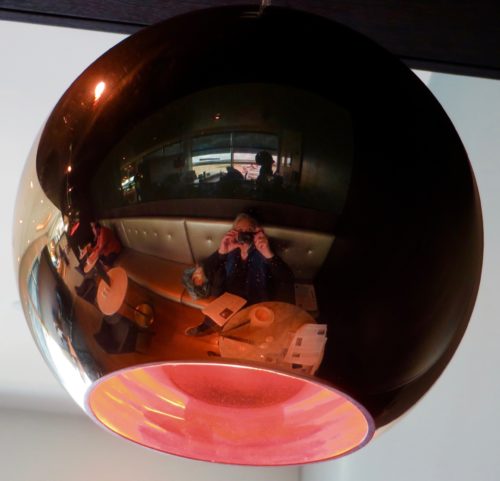
Reading about Jules Verne, the explorer… set in pink aspic at the airport ..
Arriving at Catania airport at twilight, Rosaria, our guide, was waiting for us. Salvatore, our driver, was soon busy packing our bags into the bus. One hiccough, as somebody left something on the plane but we were soon ensconced in the Hotel Principe for two nights.
By now, it was quite dark but the steep flight of steps outside the hotel leading upwards, beckoned. A white ghost of a church facade peered down on us from the top.

Catania – church façade – like crumbling icing sugar … we are in Sicily!
We climbed many steps, then it was right or left? Right. A white oleander tree in full bloom led to a small restaurant with vases of flowers on rustic tables outside, and a lively ambience of 60s music.
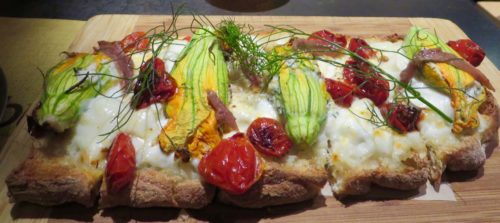
Food in Sicily is excellent … courgette flowers stuffed with ricotta
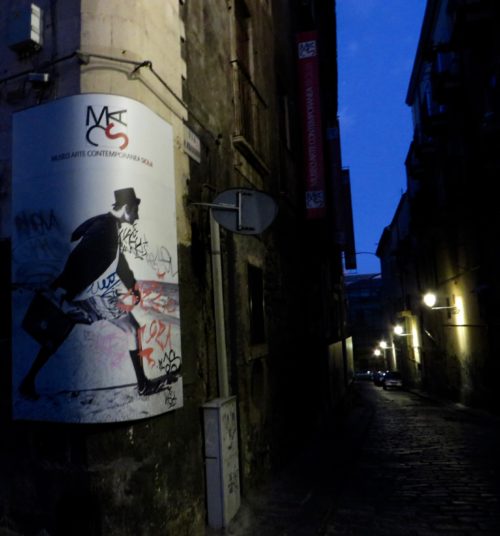
Back to the hotel for a good night’s sleep …
If you travel in a group, you get up early because you’re going to see as much as possible in a short time. As a group we were impeccably punctual – although the Frenchman often sloped off for a coffee rather than listening to the local guide – he had bad feet …
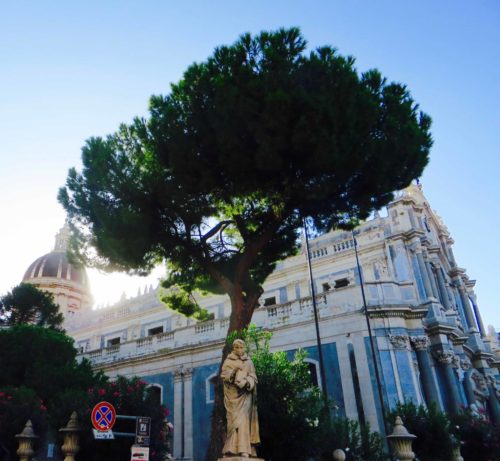
Catania – cathedral

Catania – early morning in the square …

Catania has a special bond with elephants …

Catania – remains of amphitheatre made from lava from Mount Etna …

Catania – a headless statue miraculously directs the traffic …
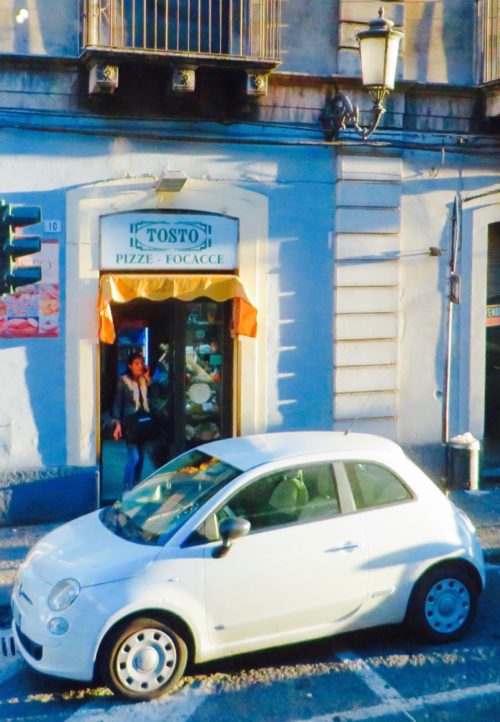
Catania – the ubiquitous Fiat …
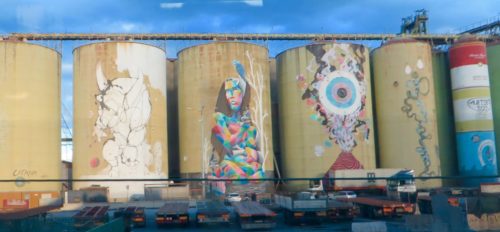
Catania – passing by the docks …
There is endless graffiti everywhere. That and the amount of plastic rubbish lying around is the downside of an otherwise beautiful and fascinating island, drenched in the history of numerous invasions. Some of the graffiti is just ugly but some of it, with a colour palette of Renoir, is quite beautiful in its way.
Graffiti by night

Catania – graffiti by night …1
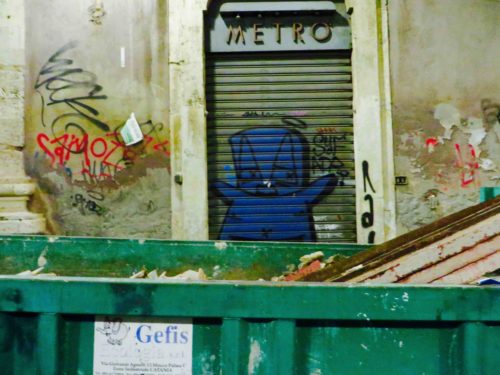
Catania – graffiti by night 2
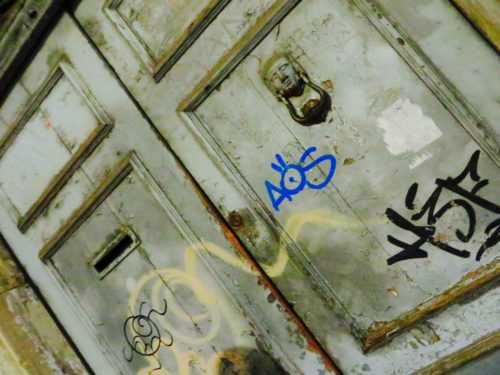
Graffiti by night 3
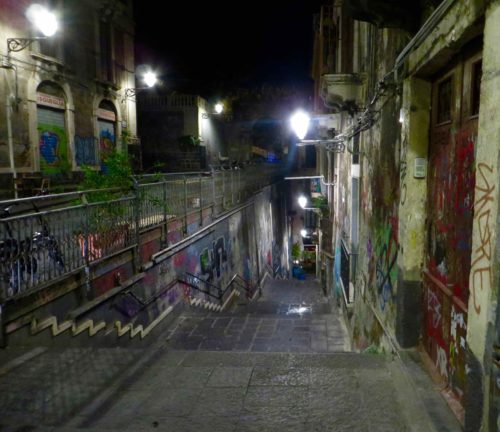
Catania – graffiti by night 4 -steps leading to the underworld …
Washing and graffiti by day …
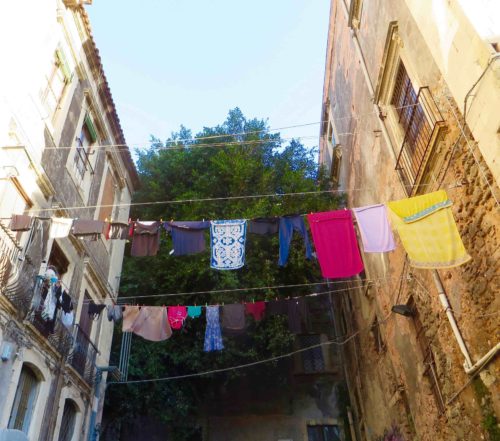
Catania – vibrant washing lines …
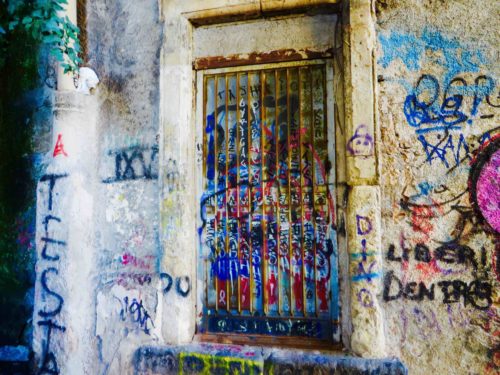
Catania – graffiti by day
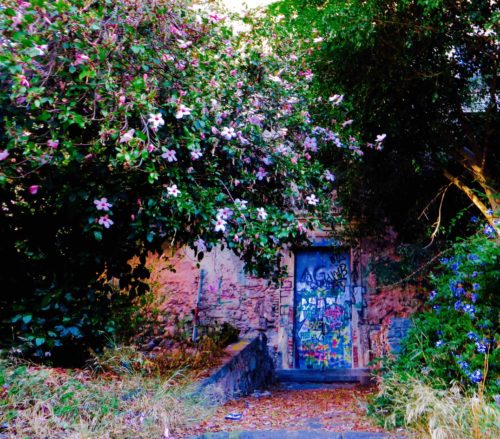
Catania – garden graffiti with a Renoir palette …
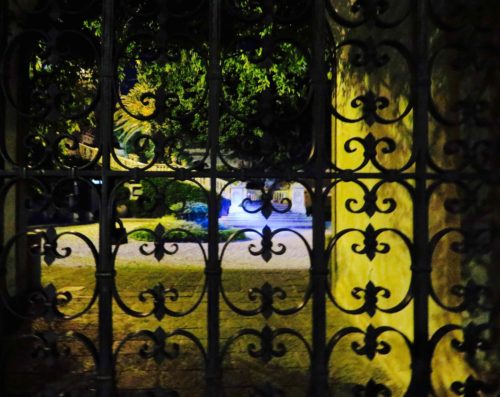
A glimpse of a private garden belonging to the university … graffiti – less!
Rosaria loves her city, set under the shadow of Mount Etna. It has a strong character and I would like to explore it further. But now it was time for supper and next day we were bound for Syracuse and Ortigia.
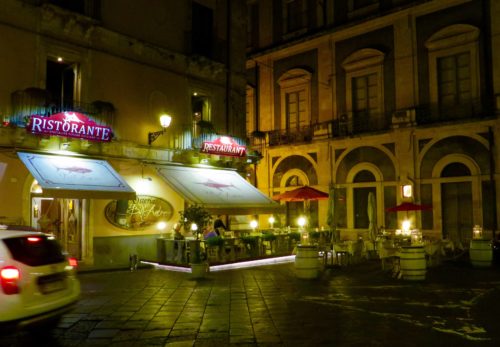
Catania – fish supper
The sun came through as we left the hotel next morning. This city is very different from what I had expected – curiously engaging.

Catania – Arrivederci …
Salvatore greets us as we arrive at the bus. He’s a good man and will turn out to be an excellent driver.
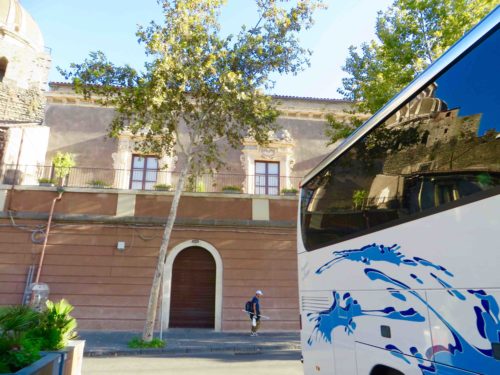
Leaving Catania for Syracuse and Ortigia … the sun is shining… the bus is waiting …
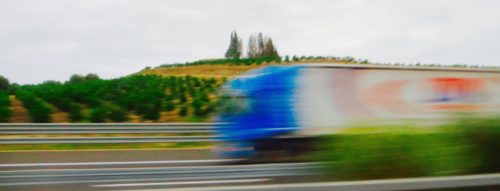
Speeding along to Syracuse and Ortigia
On the way to Syracuse we stop off to explore ‘the Ear of Dionysus’. This cave was so named by the artist Caravaggio, when he was taken to see these old stone quarries. It is pointed and rather satyr like. The stone was used for building and the enormous caves left over were used as prisons over many centuries. The echo effect in ‘the Ear’ is extraordinarily powerful. The site is vast, with many other caverns.
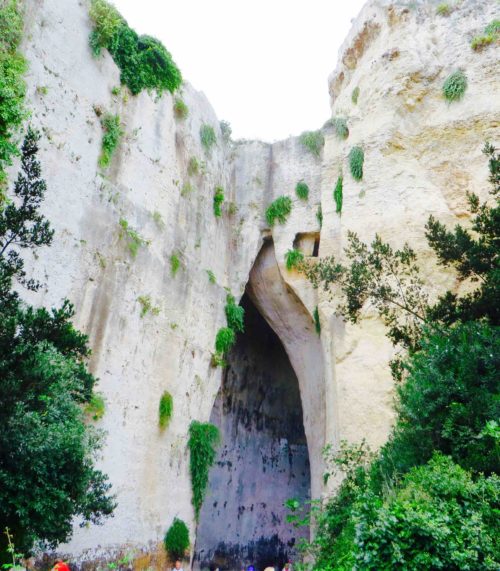
The Ear of Dionysus in the old stone quarries at Latomie …
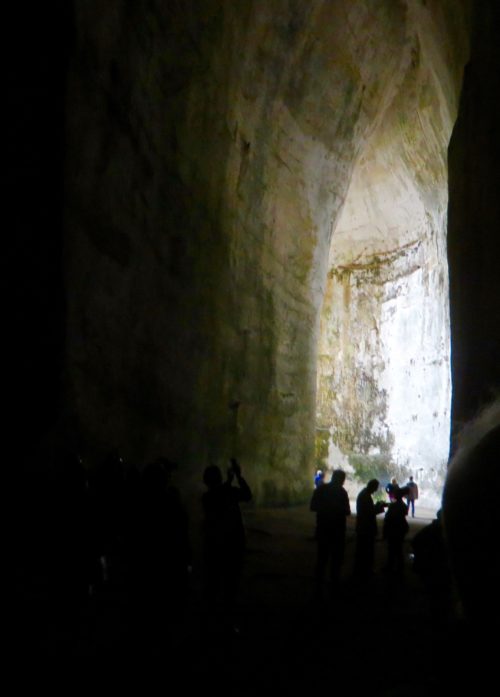
Inside the ‘Ear’

Escape – it was easy to get lost in here – and we did!
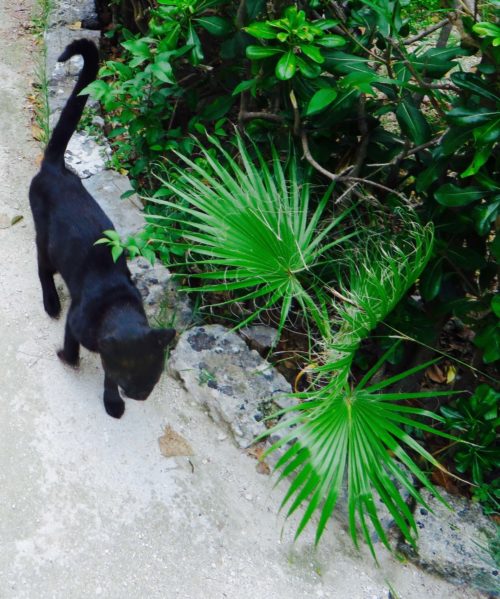
Guardian of the caves

Syracuse – an exotic fountain
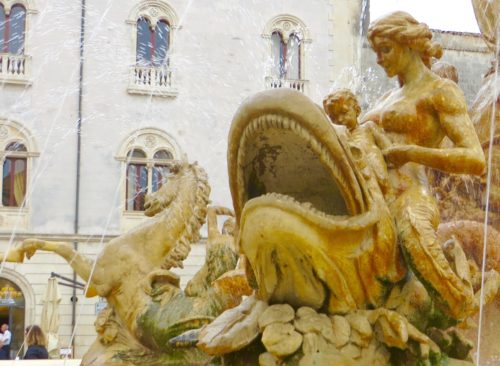
Syracuse

Map of Syracuse and Ortigia island …
Syracuse, one of the most powerful cities in the Mediterranean round about 500BC, is where Archimedes was born and where Plato and Pythagoras lived. Both Syracuse and Ortigia very much appealed to me – Ortigia is an island, part of Syracuse, reached by a bridge.

Crossing the bridge to Ortigia island
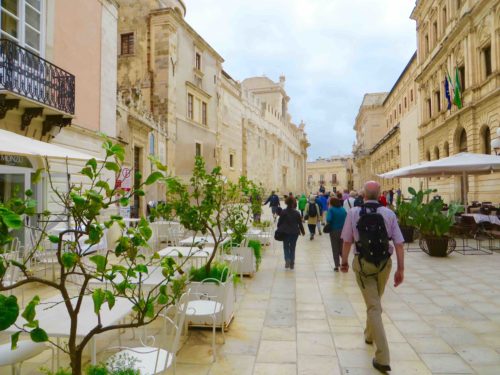
An Englishman abroad sees a distant bishop on top of his cathedral … a cool cat?

The square in front of the Duomo …
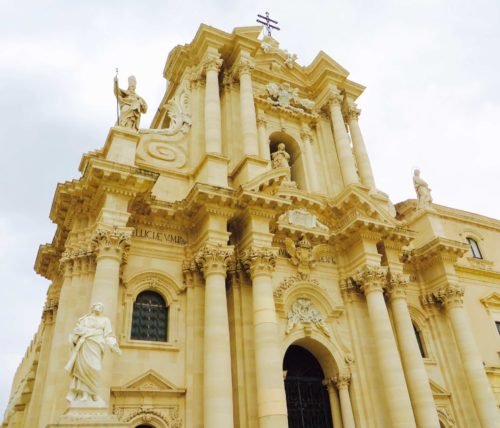
Ortigia – Duomo and bishop – full frontal
There was an ongoing miracle outside a building which housed a small museum, dedicated to Archimedes. John enjoyed the exhibition inside – much balancing of things in order to achieve more miracles. It was actually very interesting but physics is not my strong point. I’m impressed by people who do understand it and will in the end, discover the meaning of the universe and what makes it tick. I will be listening …

I liked this small miracle though … how did she do that?!
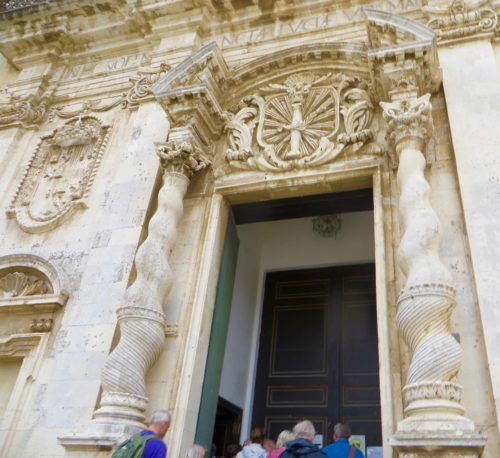
… spectacular, barley sugar pillars

Mirror images
By now, hunger was setting in and Rosaria gave us one and a half hours to have lunch. We moseyed down some narrow streets …
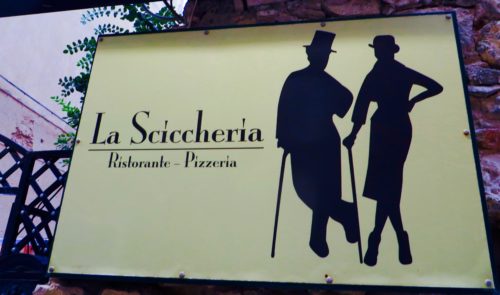
Where should we choose to eat?!
Ending up at the harbour, we then retraced our steps down a narrow alleyway …

Ortigia – the harbour … feeling hungry …
… coming upon a modest restaurant. With no more ado, we found ourselves sitting down and being served by the most delightful waiters, one of whom looked of a literary bent – tall, lanky, round glasses, floppy brown hair. All of them wearing long, white, tied aprons. I was famished … all was delicious. ‘Locanda del Collegio’, Siracusa.
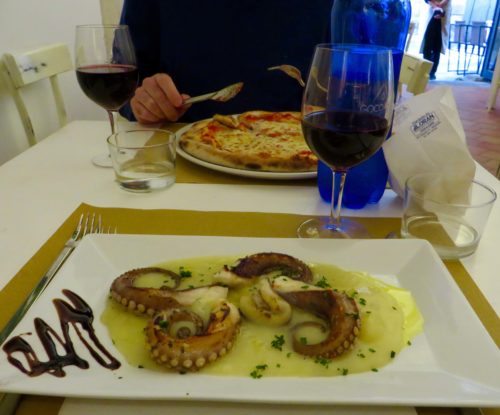
Sicily is known for its delicious dishes …
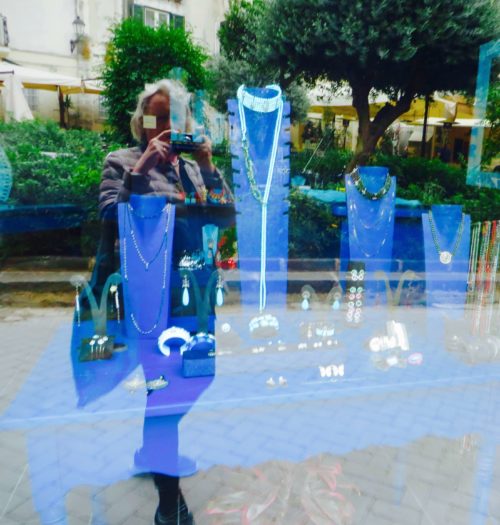
Ortigia jewels …
I didn’t buy any jewels but as we made our way back, I saw this plate and had to have it. I bought it in the ‘Ortigia’ shop which also sells soaps and perfumes. There is now a branch in London, just off Sloane Square. I was recently given a very pretty box of bath salts, ‘Fico d’India’, which have a delicious perfume.
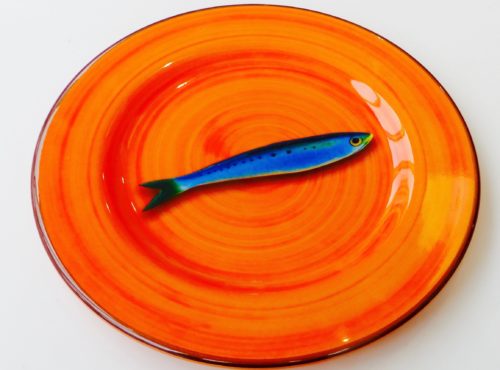
Near the bus there were several makeshift stalls, hooking in tourists. Young Arab or Egyptian men selling belts, hats and scarves. I bought a soft, muslin scarf – blue butterflies on a grey background – for five euros. These young men have a precarious existence. They persevere. But what does the future hold for them?
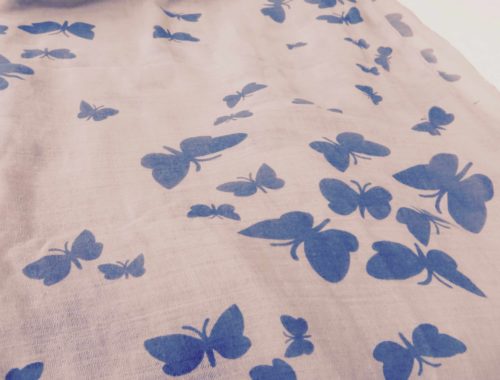
Butterflies, scattered by the winds …
Next day and we are speeding inland, to visit the fabulous Roman Villa del Casale at Piazza Armerina.
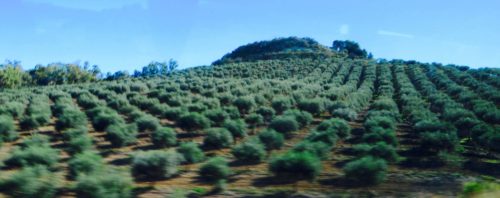
Taken from the bus – lemon trees
The exquisite mosaics here were preserved because of flooding which covered them in mud in the 12th century. They were rediscovered in the 19th century. The number of them is overwhelming – I can only show a few but this visit is a must, should you go to Sicily. There were bikini girls long before modern times!
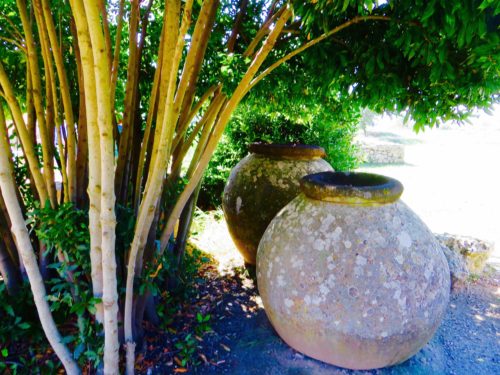
Entrance to the Villa del Casale – Piazza Armerina
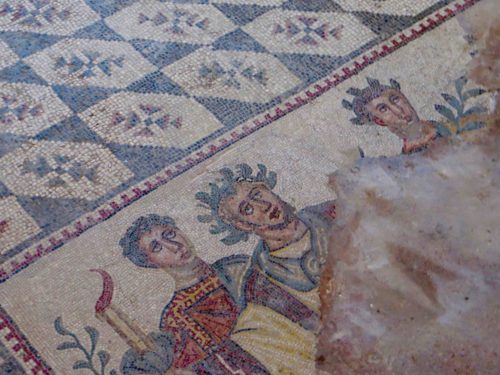
Leaders …
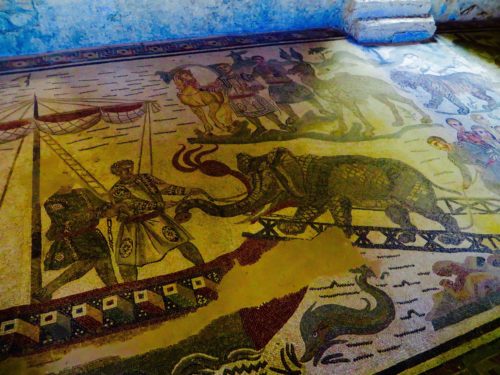
On land and sea
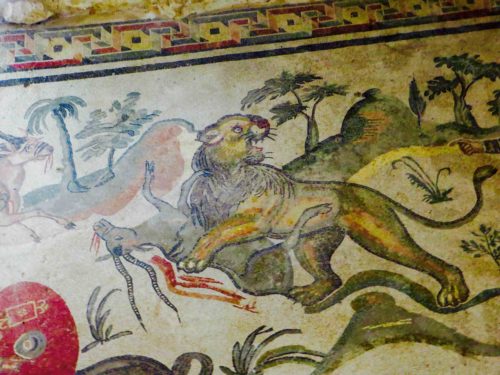
Red in tooth and claw …
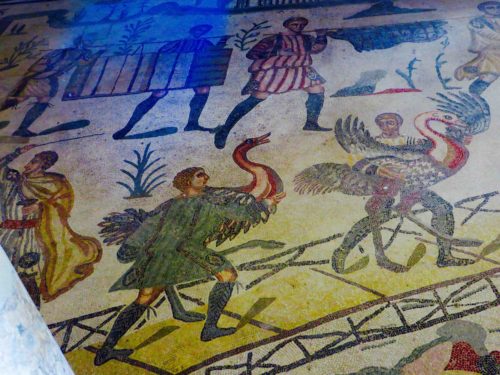
Big birds …
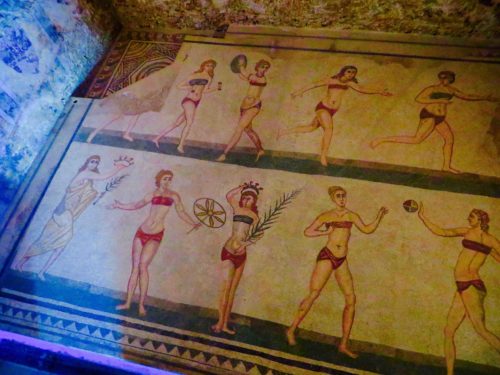
Girls in bikinis at the gym! What goes around, comes around …
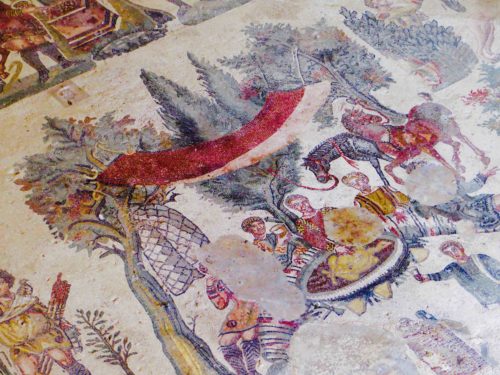
Picnic in the forest ?
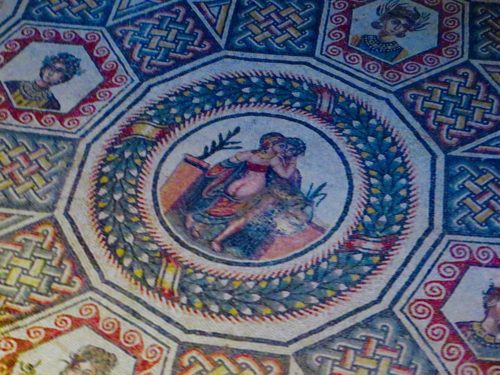
More leisure pursuits …
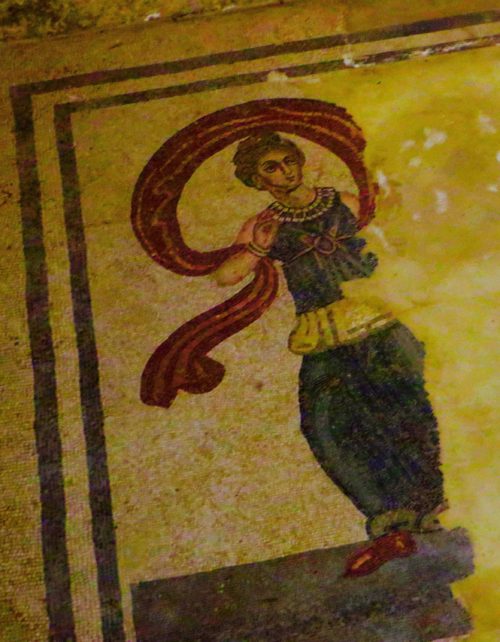
Farewell from a mysterious beauty …
The major discoveries, which made the villa famous for these Roman mosaics were excavated between 1950-1960. it’s an exciting and beautiful place to visit. And apparently even more to discover …
But it was time to move on, to explore the Valley of the Temples at Agrigento. I don’t know what Salvatore does while we are sightseeing but he’s always waiting for us by the bus, with a welcoming smile.
Lots more to see – a fresh sea breeze gently fans my face. The temples are not in a valley but on a ridge outside the town. We walk all the way along it.
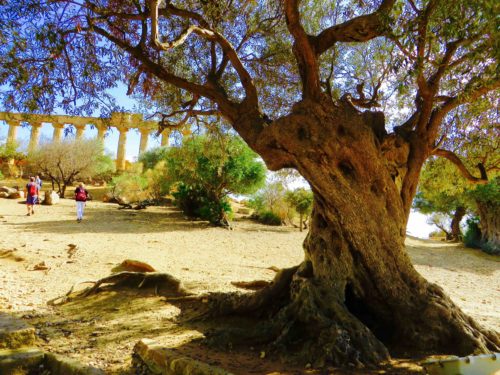
The Valley of the Temples – Agrigento
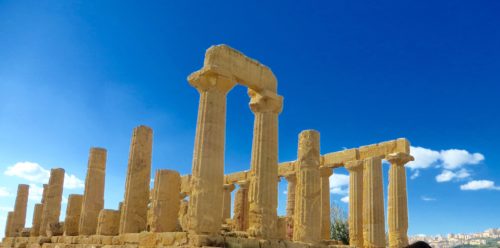
At Agrigento
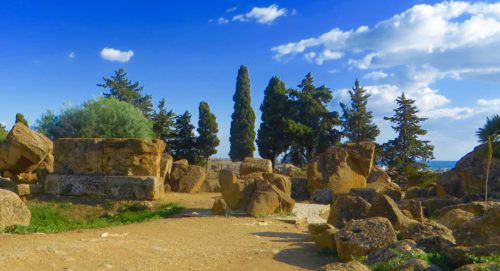
Trees at Agrigento

Agrigento – unknown couple looking out to sea …
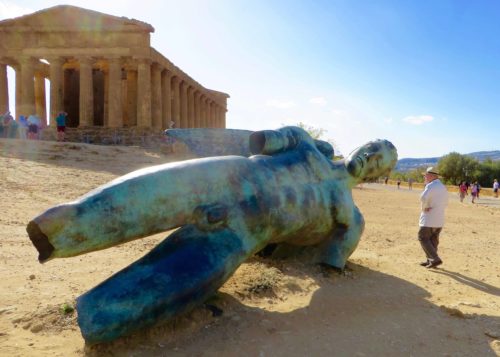
High drama … Icarus at Agrigento
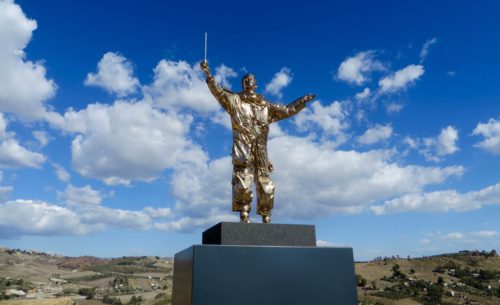
Agrigento – conducting the cloudscape …

Temple of Heracles (6th century) – Agrigento
A fabulous day and we now arrive at the hotel Dioscuri on the waterfront, surrounded by palm trees. Our spacious room looks out to sea. It has a balcony, a king size comfortable bed, lots of hot water and a bath to luxuriate in. A great choice for us by Jules Verne!
Our guide, Rosaria, has recommended a restaurant nearby. The sun is going down as we make our way over there. The holiday season has almost come to an end and most tourists have gone home. I’m quite glad about this.

Evening shadow captured on way to restaurant …
I wanted to watch the sun go down over the horizon – thoughts of seeing ‘le rayon vert’ – the colour wasn’t green – but it was spectacular.

Evening light, Agrigento

Nightfall
For a few minutes the sky was lit up like a fireball. I didn’t think a photo would come out looking directly at the sun – but it did!
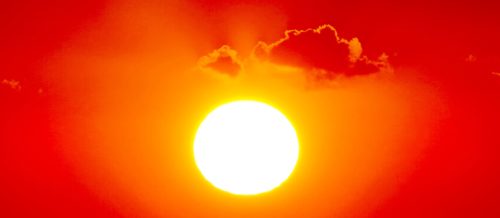
Spectacular sunset, Agrigento
Next morning we were up bright and early but couldn’t find breakfast – finally tracked it down to a separate building in the gardens, where everyone was busy scoffing delicious pastries. We had a short time to explore the harbour before setting off for the archaeological museum.

Sea wall with weird boat on the horizon …
The wall has collapsed in a number of places – due to storms?

Maritime poster – appealing colours …
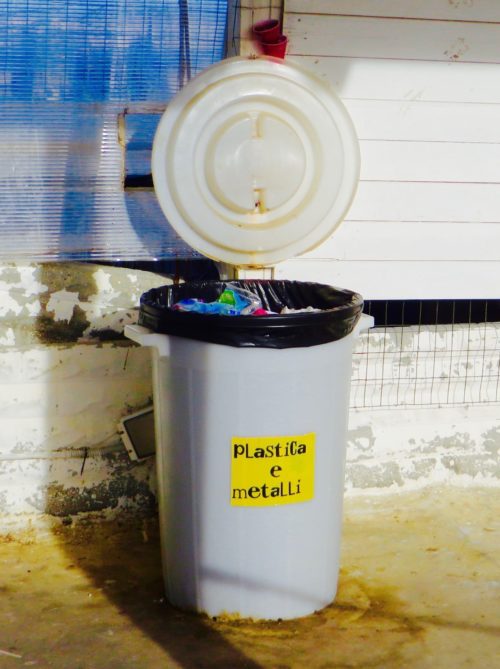
At least it’s a start … I hope it’s all recycled …
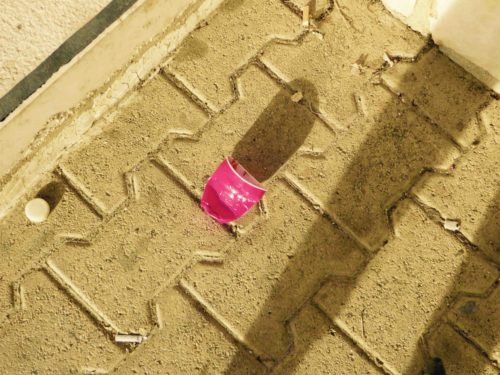
Why are you not in the bin?!
One of the downsides of Sicily is the amount of plastic rubbish overflowing almost everywhere in towns and cities. This happens all over the world but it wouldn’t take long for Sicily to clear theirs up and to have more of these recycling bins everywhere. This was the only one I saw.
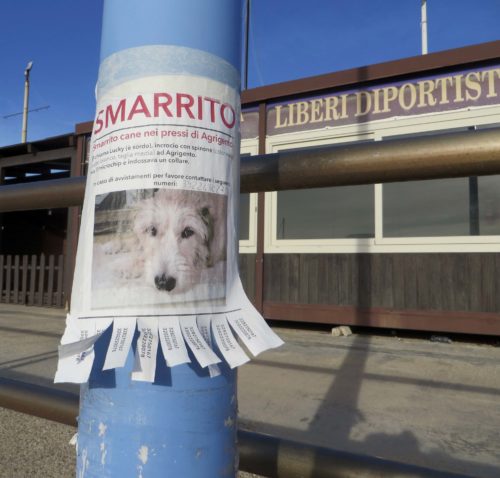
Lost dog looking mournful …

It would be easy to drive off the edge into the harbour by mistake, especially in the dark – but you have been warned!
No bathing as the harbour is chock full of boats.

Picture postcard – beautiful blues …deeply tranquil …
The Agrigento Archaeological Museum, set within picturesque gardens, is quite special – well worth a visit. As ever, Salvatore is here on time to take us there.

Arriving at the bus …
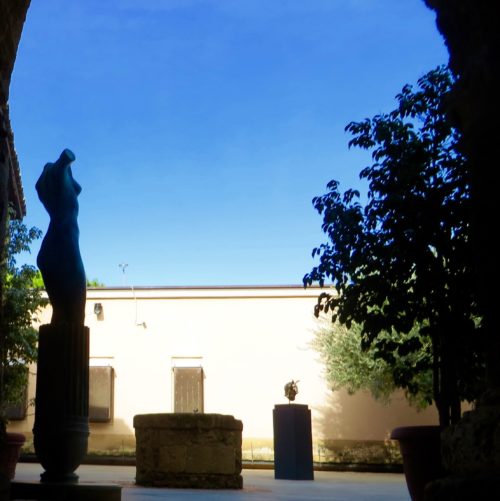
Entrance to the Archaeological Museum …
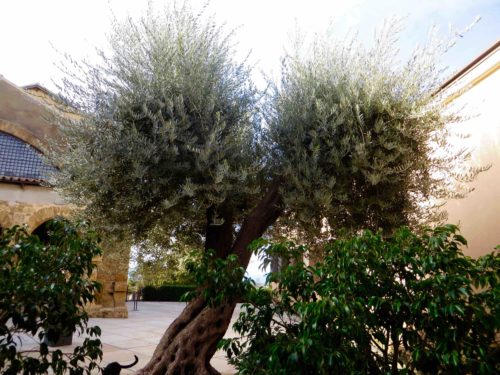
Siamese twins!

Gardens at the Archaeological Museum
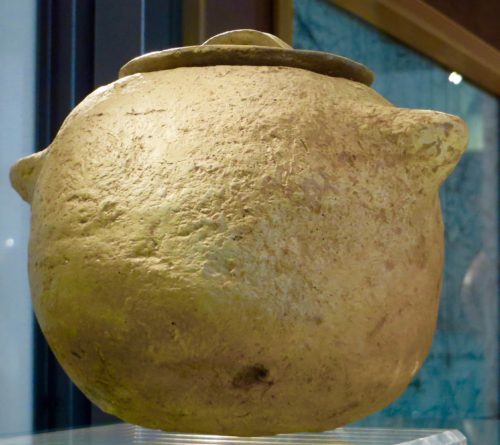
A very portly pot – could be full of a delicious goat or rabbit stew?

A vigorous youth …
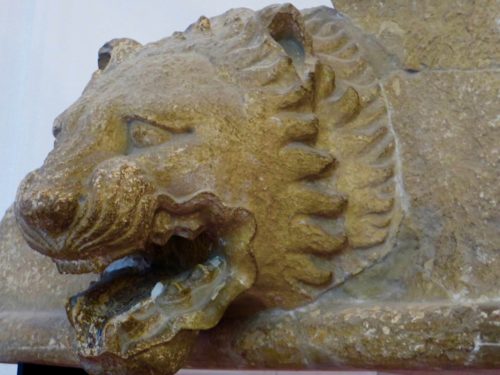
A lion roars …

Amphora recovered from the deep …
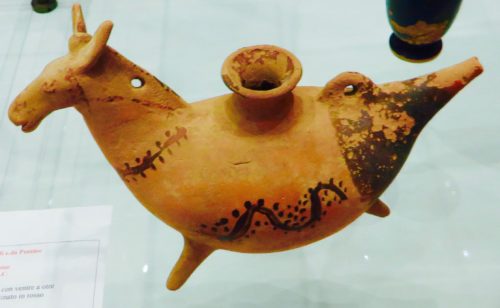
So adorable … so old, so full of sweet humour … and, miraculously, still in one piece …

Ghostly amphorae with a story to tell … robots of yesteryear? They have me in their sights I fear … shades of the Daleks
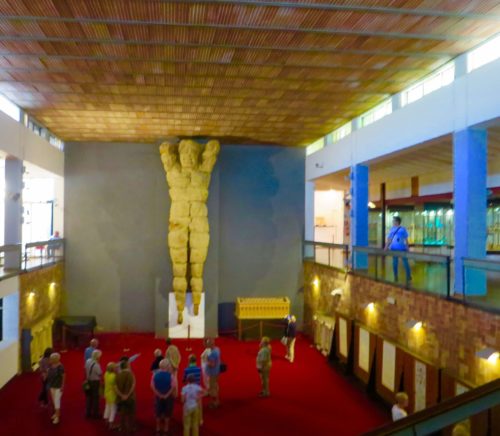
Like Atlas – holding up the world …
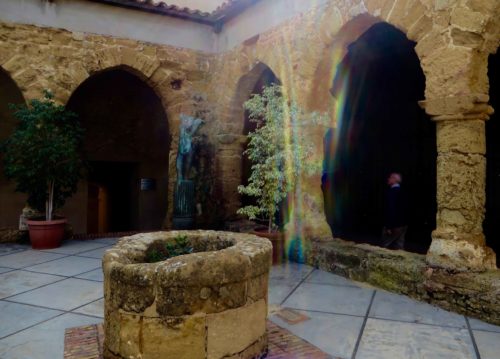
Under the arches …

Black cat …
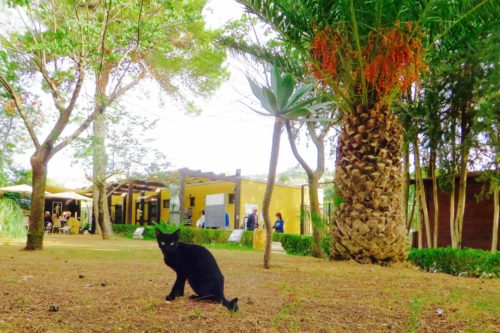
An implacable stare – I get the hissy feeling we should be on our way …
Next stop Selinunte. We follow the coast road – lots of EU money has been spent on the modern roads in Sicily and we speed along smoothly. Many of the motorways are elevated. Selinunte is near the sea and the landscape round and about is enchantingly beautiful. We meet up with a local guide, who explains the history of the temples. She knows her stuff. Will I remember it all? Sadly, the battery ran out on my camera so I have no photos – I can only say that I really recommend spending time here. I’m now a bit grumpy as we once again return to the bus to plough on to Palermo.
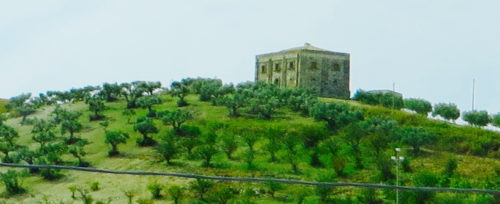
House with orchards taken from bus …
Sicilian oranges and lemons are famous and grow here in abundance. If you want to know more of their history in Sicily and Italy in general, there is a very informative book called ‘The Land Where Lemons Grow’ by Helena Attlee. Here’s a picture of my own, somewhat dog eared, copy. It’s delightful and even includes recipes …

‘The Land Where Lemons Grow’ by Helena Attlee.
After the peace of the day, Palermo is exactly how it sounds – buzzing (noisy), agitated, full of traffic, busy shops and restaurants. The hotel Excelsior is very central and our room is light and spacious. Recovery.
Rosaria suggests we might have supper at a restaurant she knows well. In the end, nearly everybody turns up there and more tables and chairs have to be found. Salvatore shepherds us back to the hotel as darkness falls.
Seafood includes squid, octopus, swordfish, sardines, lobsters, anchovies, whitebait. Anything cooked using aubergines is simply delicious. Pasta alla Norma is a typical Sicilian dish with tomatoes and aubergines … Try caponata, frittedda, arancini … Oranges and lemons, grown on the island, are used in many desserts, which include sorbets, ice creams, granitas and pastries stuffed full of ricotta. Rosaria has said on many occasions that Sicilians love their food – and they know how to cook! I would be so easily distracted and find myself eating a lot more – if we weren’t trapped on the bus.
We did stop off at an artisanal shop today where we bought olive oil, olives with herbs, almonds and we ate delicious panini with a pomegranate granita. One of the favourite granitas here is made with mulberries, so mulberry trees must grow here too.
Next morning is warm and sunny and our local guide in Palermo arrives with audio guides for everyone – she’s very organised.
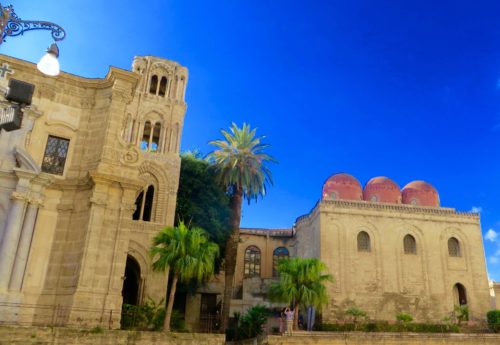
Palermo – two churches, side by side …
Sicily has been ruled by Greeks, Romans, barbarians and Byzantines, Arabs and Normans, the Spanish and the French over the years. These two churches are quite different – one mostly richly Baroque, the other Arab, plain but airy with an arched roof.
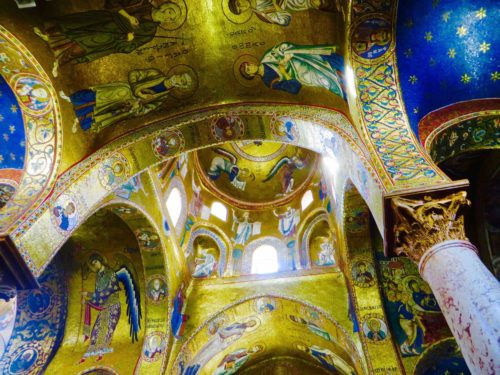
Palermo – Baroque interior

Murano glass mosaics
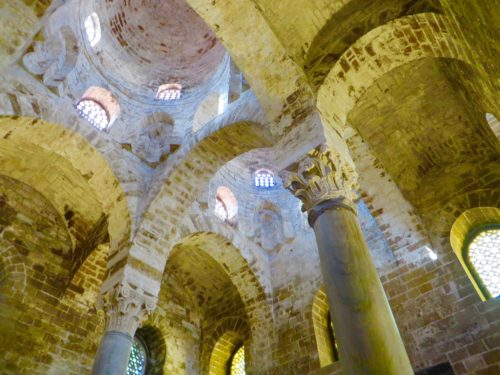
Palermo – Arab interior
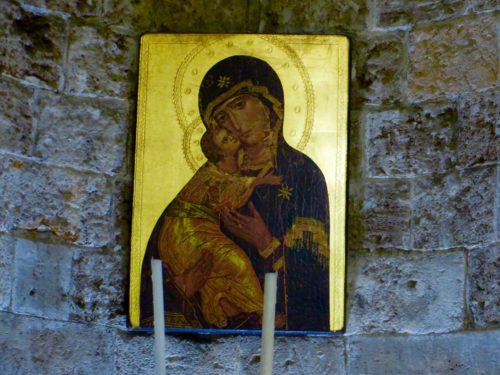
This reminds me of Duccio’s ‘Rucellai Madonna’ – same expression on the face, similar cloak trimmed with gold … I don’t know who did this …
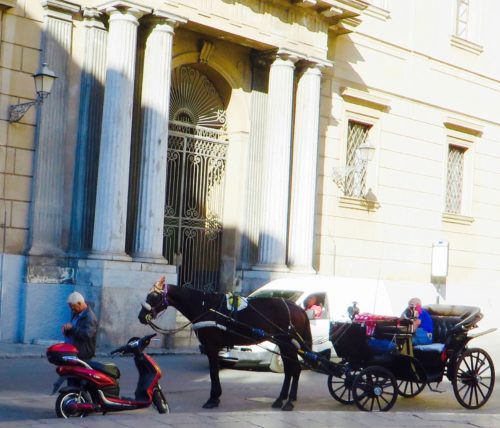
The old and the new …
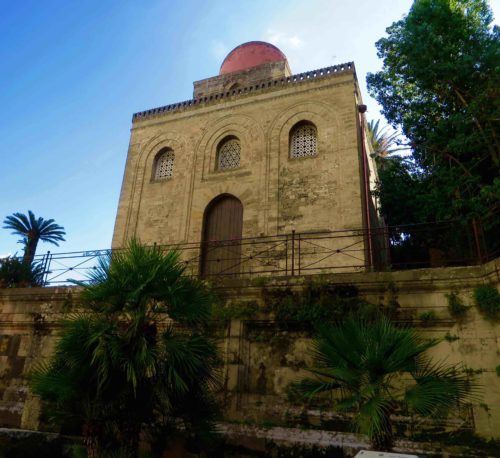
Palermo – arab influence
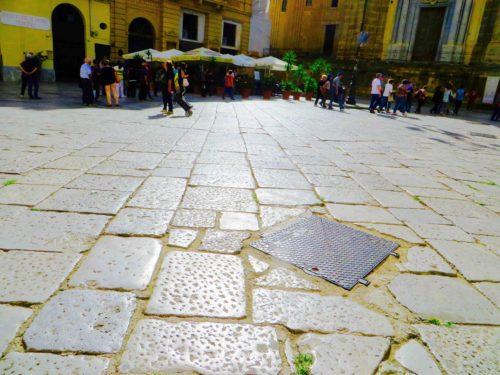
Flagstones – Palermo
Ever onwards, through the city streets on the way to the Palatine Chapel in the Norman palace. The street views show how modern commerce is imprinted, sometimes unhappily, on the magnificence of the past. But somehow, it weirdly works …
A WALK THROUGH PALERMO
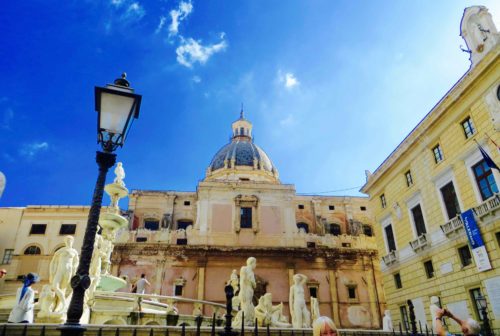
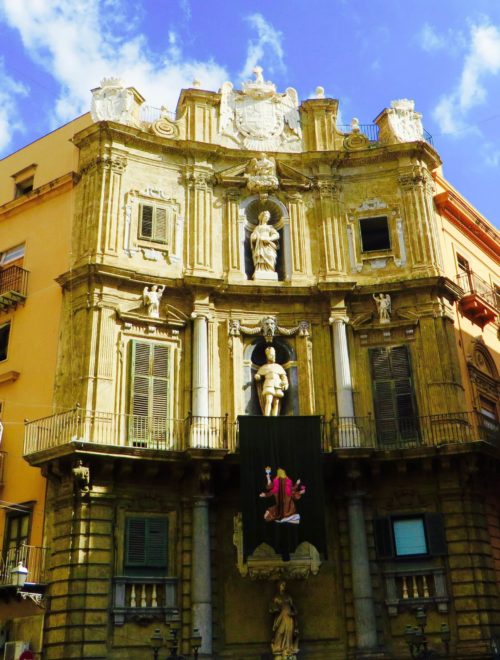
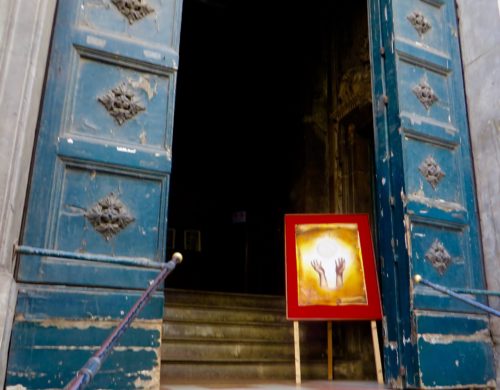
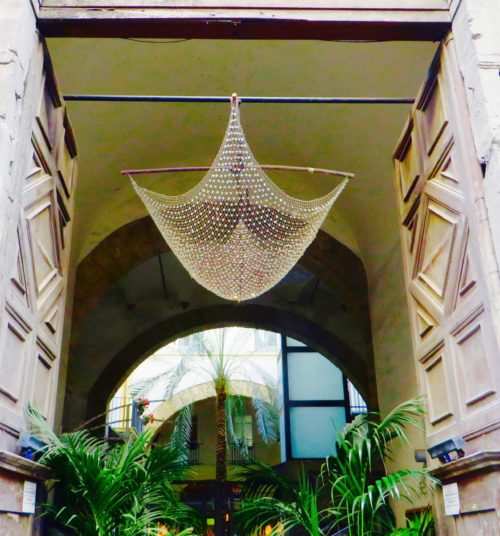

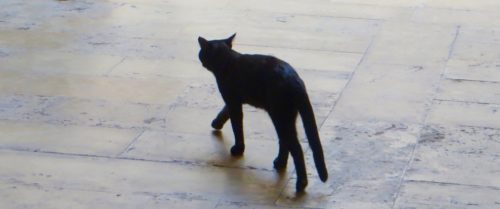
The ‘dark heart’ of Italy still stalks the land but there is hope …
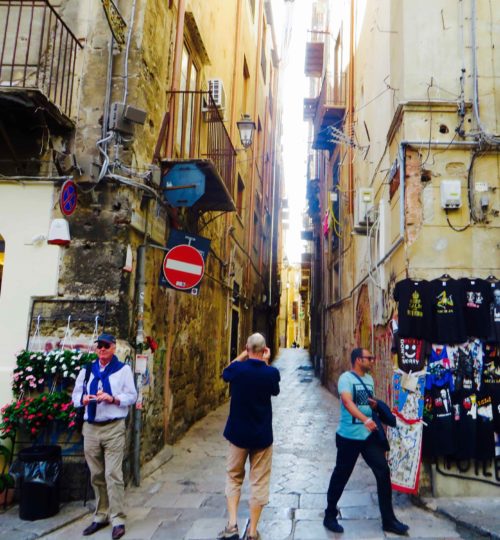

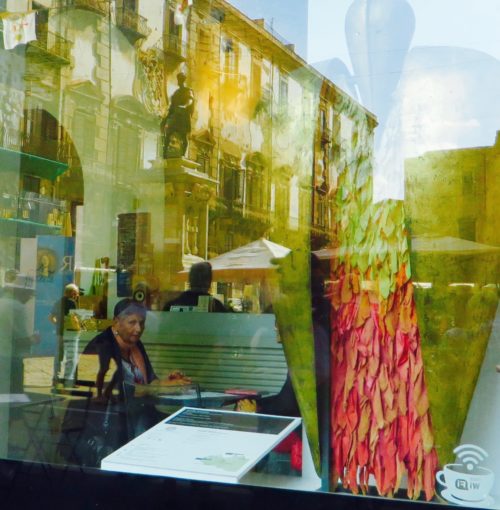
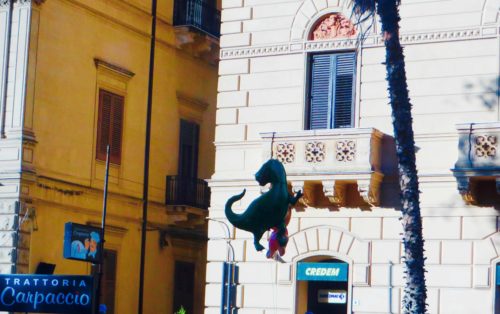
Palermo – baby dinosaur escapes ……..


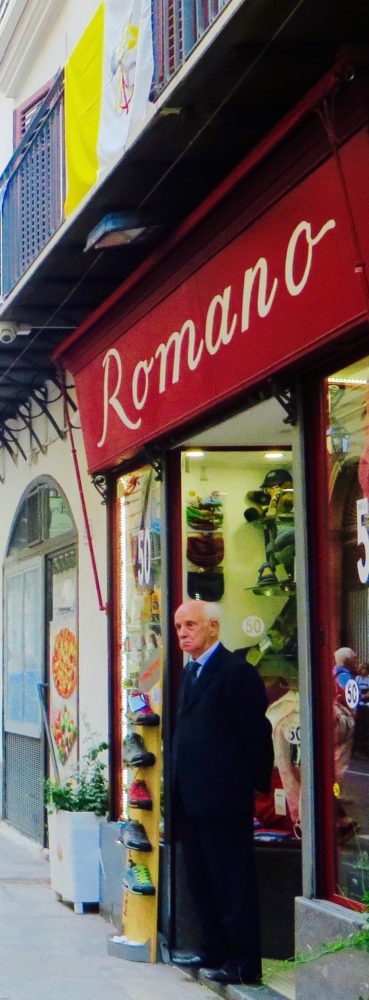
Statues, doorways, narrow alleys, stray dogs, modern consumers – except for ‘Romano’- who looked from a different era, yet surviving amongst the multi coloured trainers … spreading a little gravitas.
Now to the rather different Palatine Chapel and Palace, which is truly breathtaking.

Palermo – The Palatine Chapel – I am blown away!
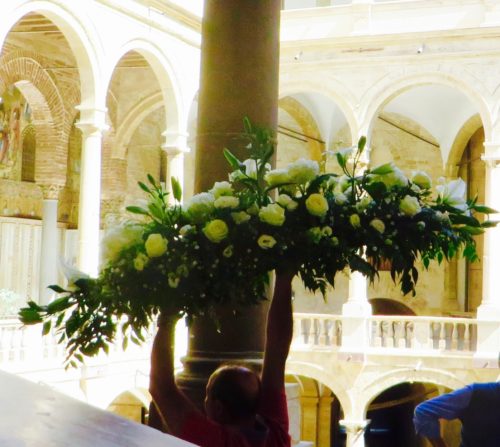
Manhandling a bouquet in the palace …
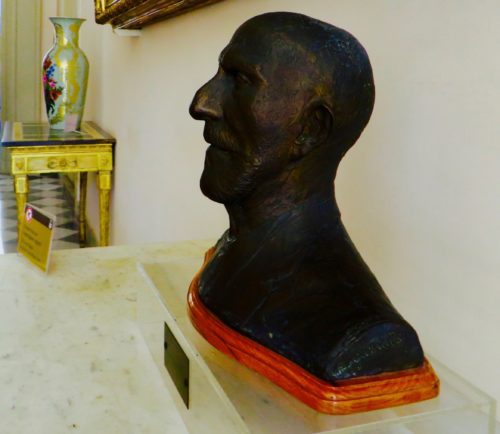
A formidable profile
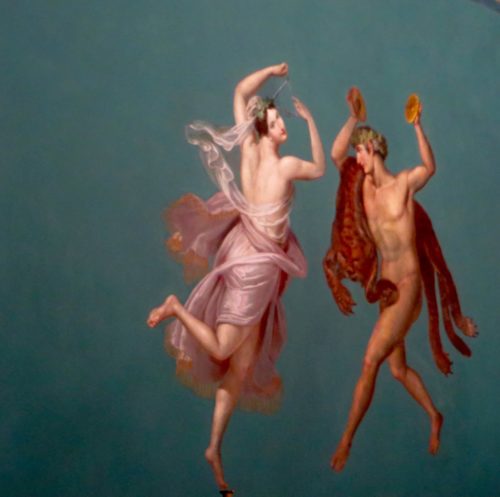
Palermo – palace lovers
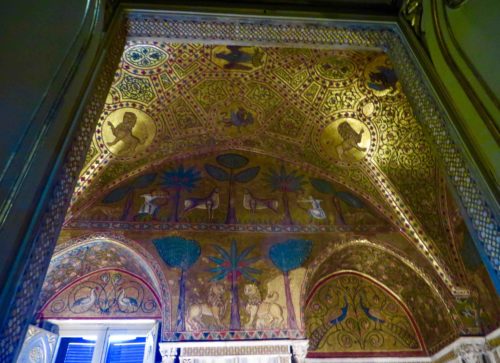
The palace, Palermo – Roger’s room

Unknown boy exploring the palace …
We finally emerge into the sunshine and Rosaria tries to herd us all into the bus, which finds its way through the back streets of the city before dropping us in the centre. Lunch time.
John and I start exploring one of many small alleyways, where restaurants abound. We finally decide on one where we can sit outside that is by buildings with green ferns adorning wrought iron balconies. It’s also a bit off the beaten track – and seems less touristy.

In my element – a whole squid – so unbearably delicious!
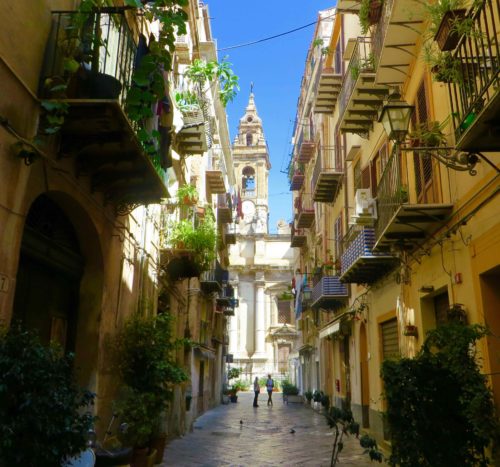
Squid restaurant, Palermo
I don’t know the name of the restaurant but this is the view from where we are sitting towards the pretty church at the end. Seek it out – you will be rewarded with an excellent meal at a reasonable price!
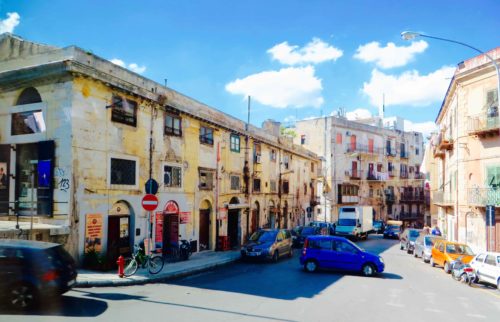
Back streets of Palermo …
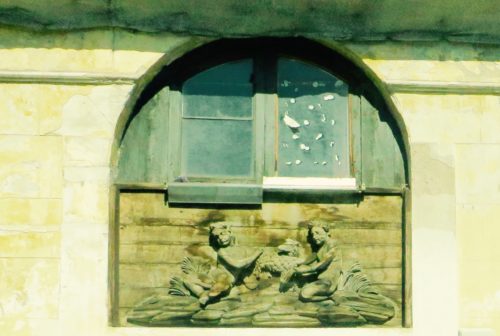
Back streets – a curious window that has seen better days …
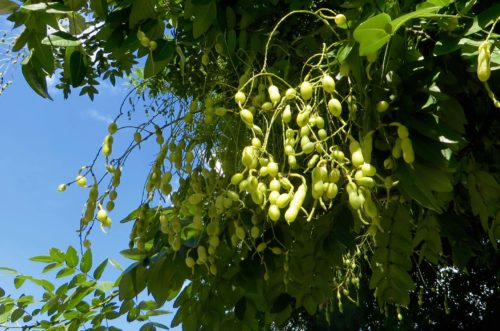
Rosaria told us that rosary beads were made from the tree berries …
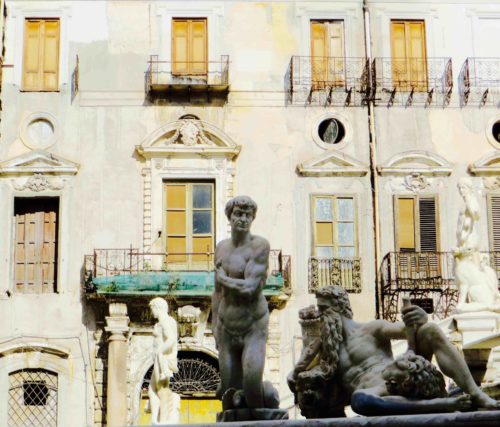
Statues feeling weary with age …
Can’t help but think the one in the middle resembles Sylvester Stallone.
We’re for the most part feeling somewhat weary too – but as tourists, we must trudge on to a special Jules Verne visit to meet a Contessa, who will show us around her domain, which is built into the ramparts. Her husband, the Comte, is a racing driver but not in evidence.
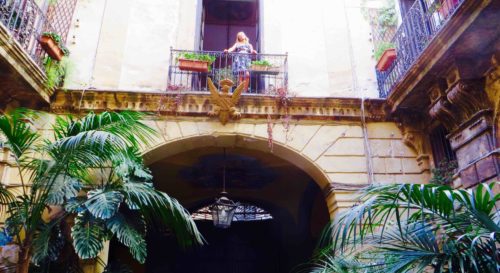
A ‘Juliet’ style welcome from the glamorous Contessa … we are charmed…

We meet up with the Comte’s racing car at the entrance and are impressed …
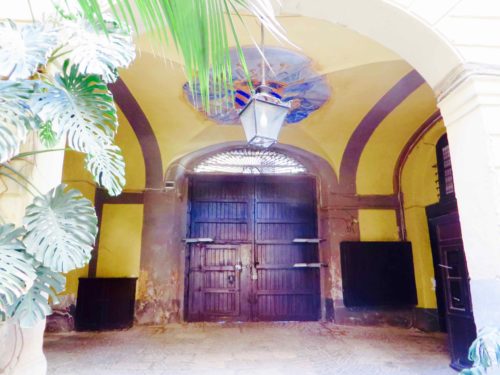
Open Sesame!
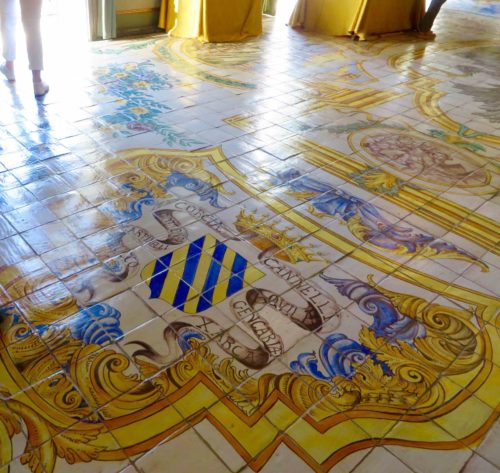
Beautiful, tiled floor …
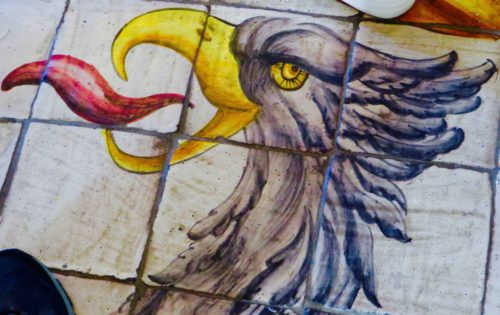
Close up …

A somewhat splendiferous mirror – can you spot the rabbit?
Some older parts of the house have been excavated.
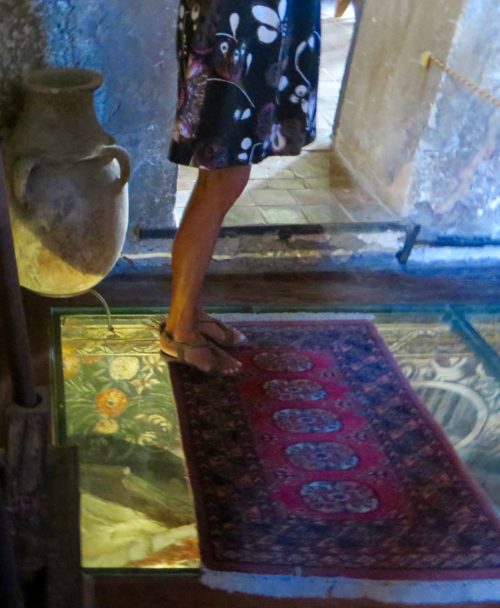
The treasures found are protected by glass …
I could only include half of the glamorous Contessa but her other half is just as ‘glam’.
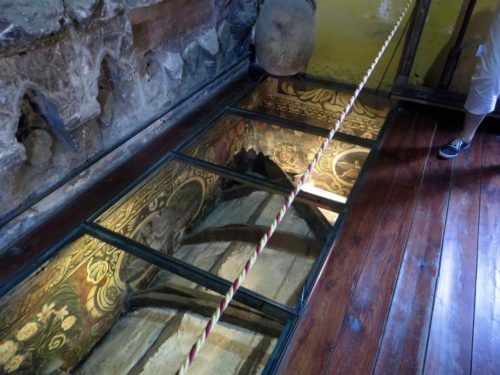
Treasure under the floorboards …
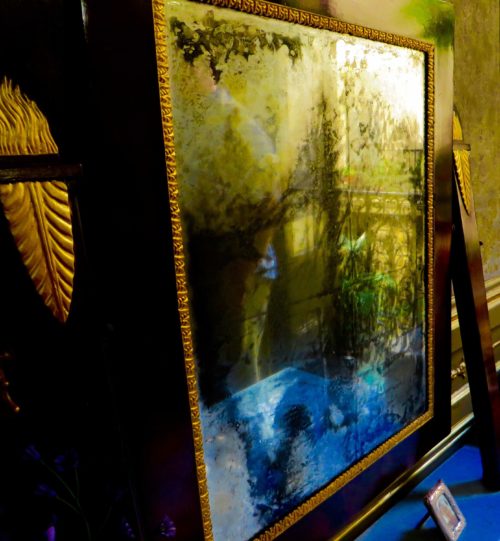
Reflections on times past and present …

A creepy silhouette …

An exotic collection of travel labels …
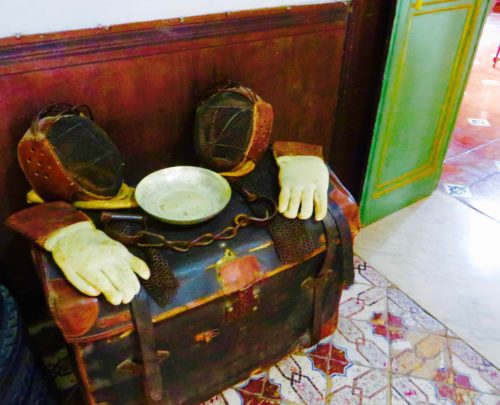
Racing, fencing and a collection of pistols – the Comte is a busy man …
We finish on a high note – the Contessa sings for us and we are offered aperitifs. An extraordinary and fascinating visit has been had.
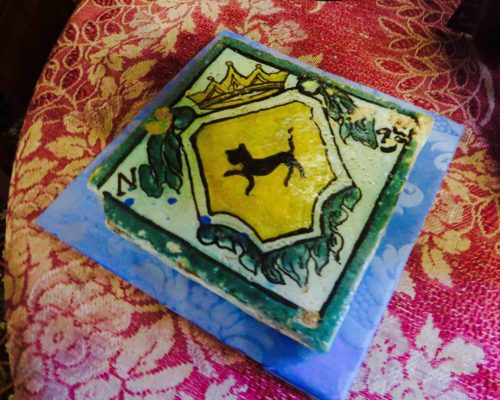
That black cat keeps turning up!
The day is over. We sleep well.
The sun is with us once more and Salvatore appears. Today we’re up and away to Monreale and Cefalù. These are both unknown to me and I have no idea that such treats are in store. I wasn’t sure about joining a group but it’s such a joy that your only responsibility is to be ready for the bus leaving. We would never have seen so many wonderful places in one week on our own. And our guide, Rosaria, is a joy.
The skies are azure blue as we climb the steps up to the cathedral at Monreale. On either side are stalls with scarves, dresses, jewellery and souvenirs of the cathedral.
After the Palatine Chapel and Palace in Palermo I couldn’t believe we would see anything as magnificent but am overwhelmed by the beauty and exquisite workmanship here. The attention to detail is perfection. I am just standing here, completely transfixed.
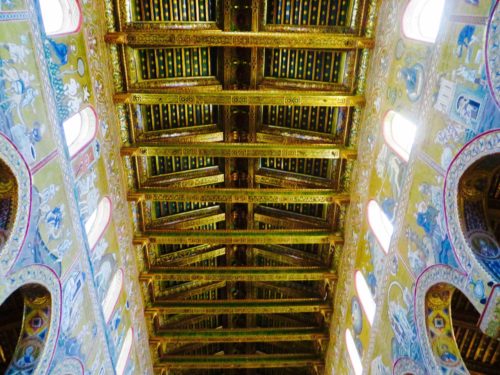
Monreale – ‘look upwards’
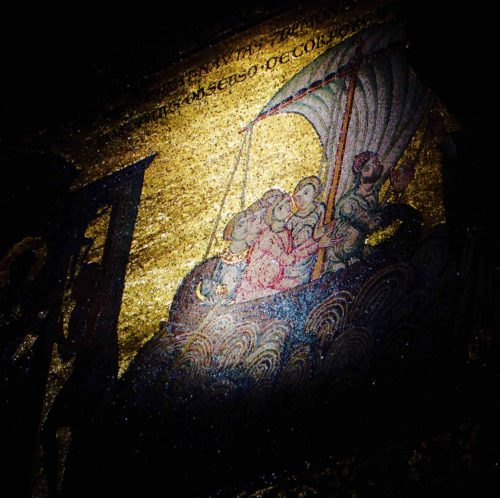
Exquisite
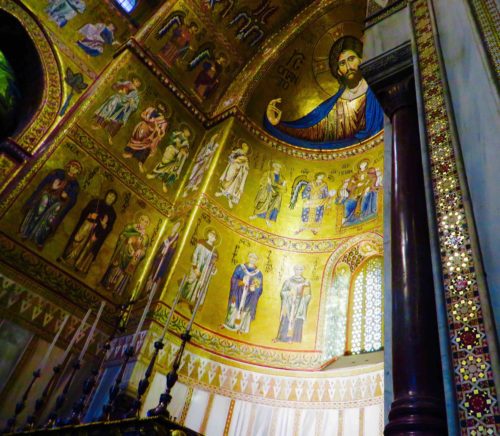
Monreale – the old …
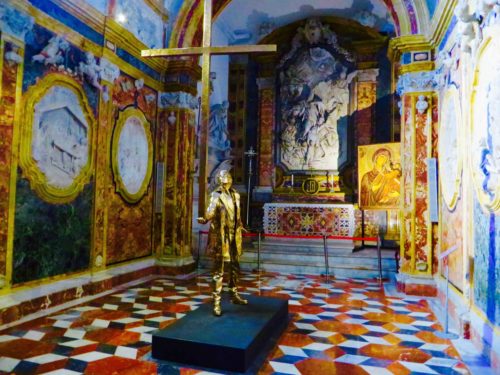
Monreale – the modern …

Monreale – cloisters …
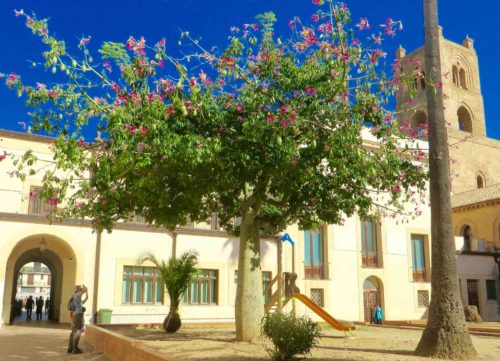
Monreale – illustrious kapok tree
I never imagined kapok should have come from such beauty – well, some things are both beautiful AND useful!
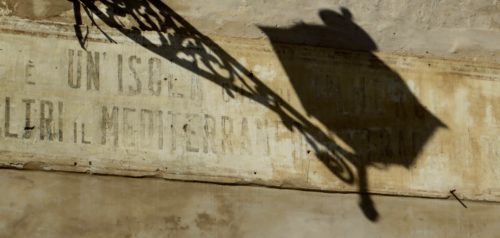
In the town square … the shadow of the mafia is still present in Sicily
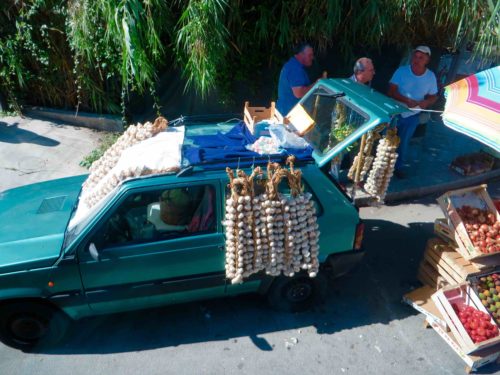
Monreale – market
I wish we could stop here but the bus is gathering speed as we leave Monreale and very soon we are out on the open road to Cefalù, an erstwhile ancient city/fishing village by the sea.
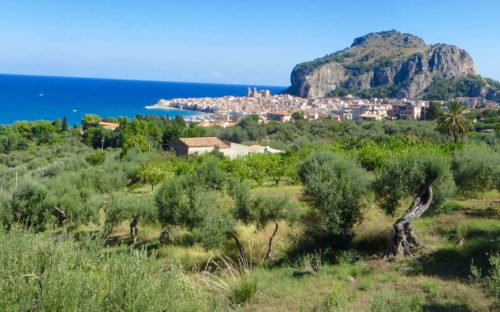
Cefalù, Sicily – belle vue
We’ve had to take in a lot of history and art and architecture over the last few days – and I’m hoping that Cefalù will provide some relaxation – just a little fishing village by the sea … ?
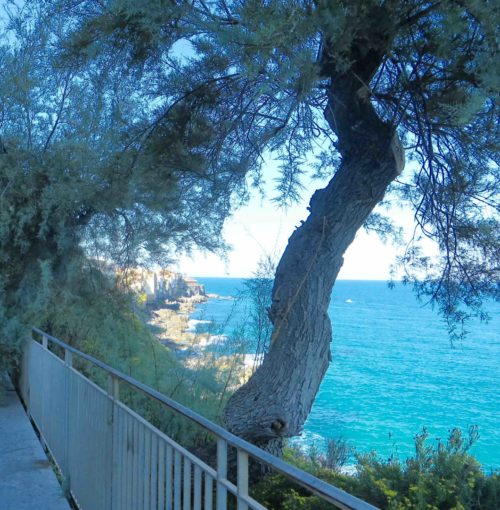
Cefalù – walking into the village – looks promising …
Time is relaxed here and Rosaria leaves us to our own devices. Sort of like playtime!
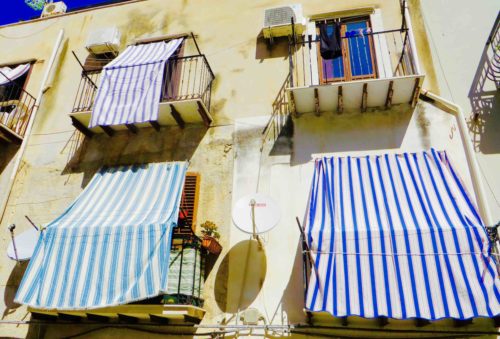
Cefalù – afternoon siesta

A yellow devil – a handsome fellow …
The little town is very picturesque and but rather grand also with its magnificent Cathedral and stone sculptured doorways.
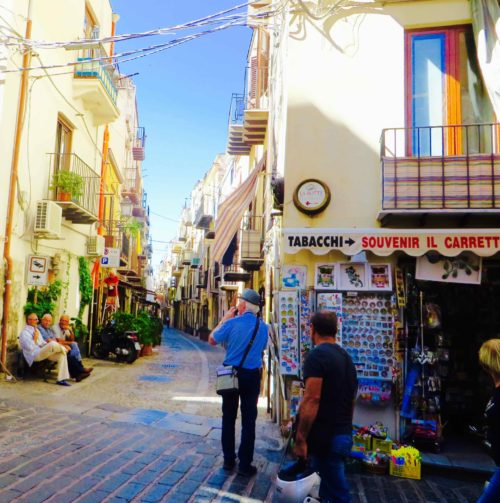
Cefalù – in the centre of town
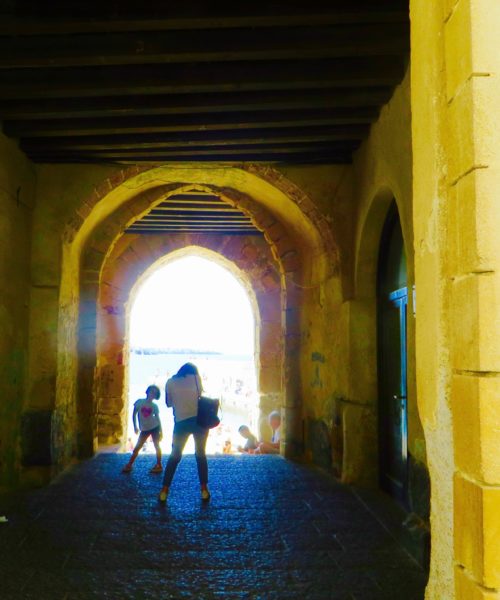
Arch leading out to the beach …

Cefalù – the Cathedral
This has an Arab-Norman façade, was built in 1131 and looks somewhat fortress like. It is splendid – not to be missed. Make sure you go inside too. In the museum opposite the cathedral is a portrait of an unknown man by Antonello da Messina. This one and the one of the Virgin Annunciate have very contemporary faces, as does his self portrait. I’m afraid the one of the unknown man has shades of Putin to him but is saved by the twinkle in his eyes! The Virgin Mary is understated and exquisite. You will find it in the Palazzo Abatellis in Palermo. It was probably painted in 1476.
If you want to know more about these paintings and the artist, there is a great ‘blog’ called ‘my daily art display’ which I have just come upon. Much recommended for all art lovers – absolutely bursting with fascinating information.

I love these old doorways … the light on the stone makes me think of John Singer Sargent paintings.
But now lunch is uppermost in my mind. A lot of the restaurants look out to sea and I think we make a good choice.

Idyllic?!

John in indigo mood …
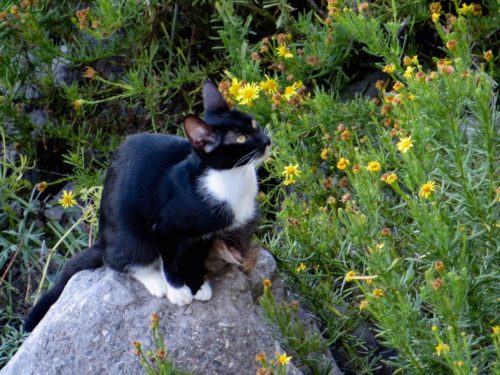
The cat doesn’t know how lucky she is – fresh air, freedom to roam and all those scraps to be had from all those restaurants … she has some kittens, if you look carefully!

The kittens are learning fast …
Just time for a mulberry and a pomegranate granita – which we enjoy sitting by the cathedral while waiting for Rosaria to turn up. Cefalù shouldn’t be missed but best not to be here in the height of summer.
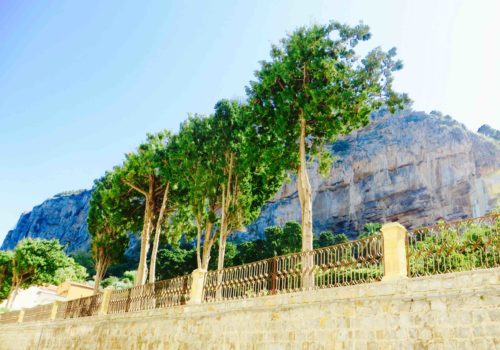
Leaving Cefalù … ever onwards …
Next stop, Messina, which is the closest Sicily is to the mainland. We don’t stay long as we need to be in Taormina and it’s already late afternoon. But we do get a glimpse of the Straits and of a beautiful ship.
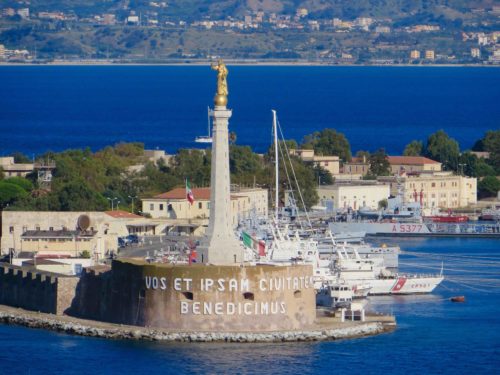
Messina – looking over towards mainland italy
The city was almost all destroyed in 1908 by an earthquake and a tsunami striking at the same time. Within the rebuilding some of what was saved has been incorporated. But 91% of the buildings were destroyed and 60,000 people died.

Photo taken from the bus …
Pressing on to Taormina, where the local guide was waiting to show us round. Our trip was coming to an end, except for an amazing finale – the ascent of Mount Etna.
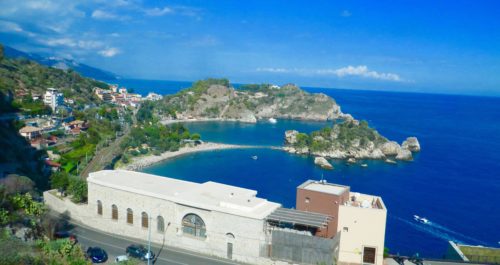
Climbing up the hill to Taormina
Taormina is high up and its famous amphitheatre has a magnificent view overlooking the sea. The streets are picturesque, a coral reef of small, tempting shops. Many celebrated people stayed here and were enchanted with this place. Ovid, Goethe, Guy de Maupassant, D.H. Lawrence, and more recently, Daphne Phelps, the aunt of a friend of mine, who bought a house here with her husband after the war and delighted in welcoming countless artists and writers to ‘Casa Cuseni’ -which still exists as a ’boutique’ hotel.
We had a special date for aperitifs on the terrace at the Hotel Villa Schuler, a place of sanctuary hidden behind the busy street outside. They also welcome writers – I was given a Campari Soda, decorated beautifully with Sicilian oranges, followed by an excellent red wine from grapes growing on the slopes of Mount Etna. We sat on a flowery terrace with a dreamy view of the sea. So many romantic villas still to explore and now, so little time … this one exceeded expectations.
No photos unfortunately – my camera ran out of battery again – so you have to go and experience Taormina for yourself. You won’t be disappointed!
Meanwhile, our own hotel was a short bus drive away with a private terrace, the most comfortable beds yet and great breakfasts on the terrace looking out to sea. I feel a great sense of (glitzy) pampering!
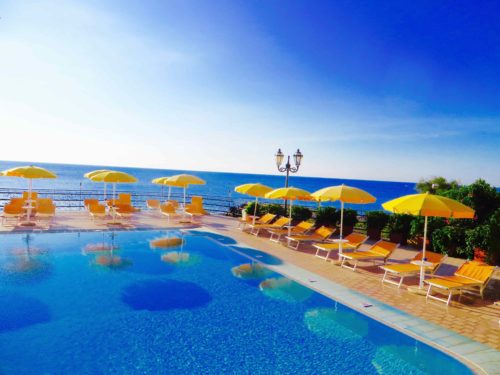
The pool at the Hilton, Giardini-Naxos

The Hilton – foyer – Giardini-Naxos

The Hilton – foyer – Giardini-Naxos
The grand finale – our ascent of Mount Etna! The sun is out, the mountain is smoking and Salvatore is waiting.
“Its a long and winding road” – towards the sky. We stop off at a small village to look at the view below.

Sunburst – climbing up to Mount Etna- stopping off for a ‘belle vue’ …
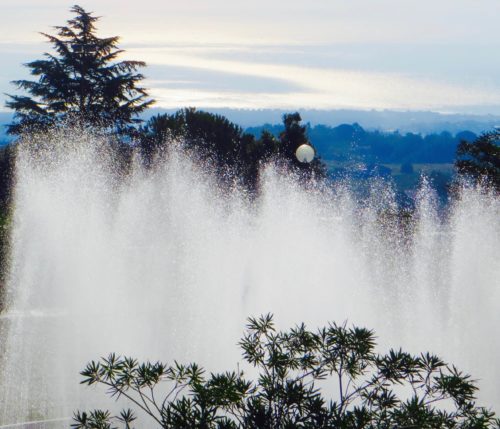
Etna – refreshing fountains en route …
Ever upwards …
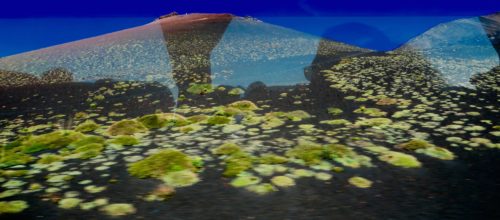
Taken from the bus – these cushion type plants survive the harsh conditions …
This ‘travelling’ photo rather reminds me of a Peter Doig painting. There are few plants which can cope with the conditions on the higher slopes but one is known as Etna broom, which bursts into yellow blossom in Spring. On the lower slopes, besides vineyards, there are lemon, pear and apple orchards, pistachio, walnut, almond and chestnut trees. Etna honey from chestnut flowers is highly prized. But as we get higher, plants and trees disappear.
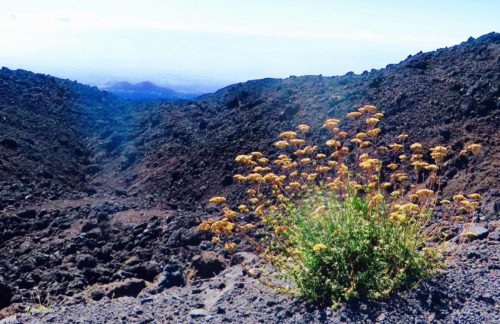
Etna – a tough, hardy plant
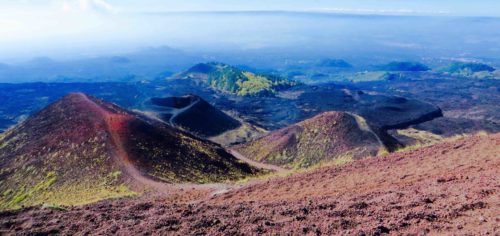
Etna has many craters, not just one – I didn’t know that!

Etna – a defunct crater

Etna – lava fields
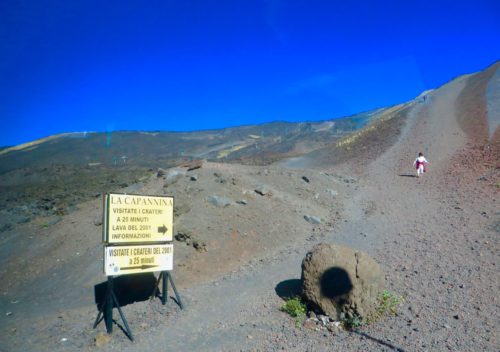
Etna – onwards and upwards

Etna – walking on lava in not so sensible shoes!

Shadows on Mount Etna …
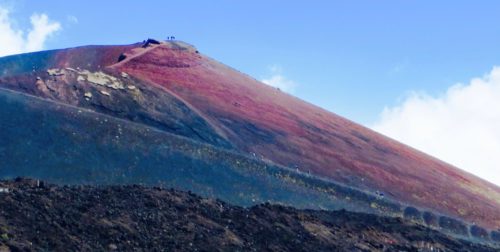
Etna – kings of the castle!
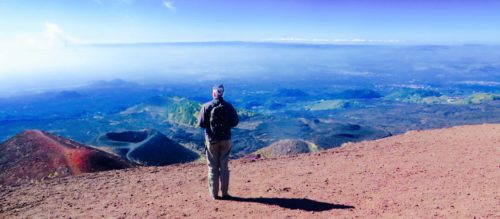
Etna – John’s view
Hundreds of ladybirds live amongst the lava fields, feasting off the remains of insects and other creatures who have died during eruptions.

Lava living ladybirds …
A local goatherd has an entrepreneurial sideline. He makes and paints wooden ladybirds and sells them sitting on a piece of lava – he’ll never run out of that!
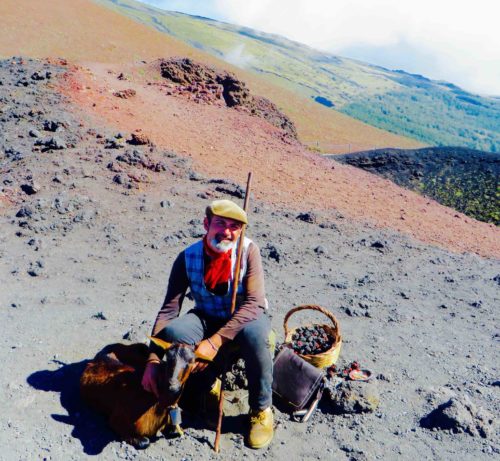
Etna – lonely goatherd with a sideline in ladybirds … !
Time to retrace our steps and fall upon freshly squeezed juices in the café. Mine is pomegranate, John’s is orange. We have two each. Then I buy a necklace, fashioned out of lava, in the shop.
The sun has dipped and clouds are rolling in. We have only lost one person. He finally turns up having been waiting at the wrong car park. I am relieved he is not at the bottom of a crater.
There’s a small supermarket near our hotel and instead of going out again to find a restaurant we buy bread, cheese, tomatoes, olives and grapes – and a bottle of wine. Early night and it’s home tomorrow.
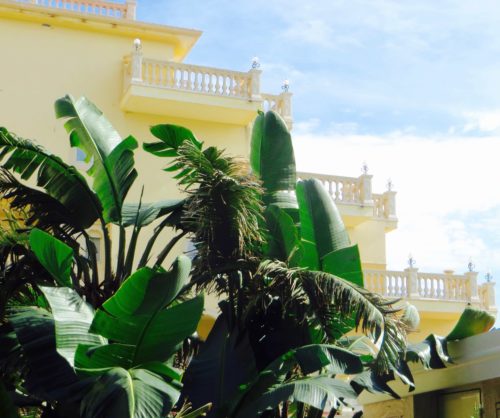
Bread, cheese and a glass of wine – perfetto!
We have the morning free and can do what we like as long as we’re packed and ready at the hotel by 2pm. I will miss Rosaria and Salvatore. I hope we go down as a ‘good’ group! They were both excellent.
We decide to just walk and explore the shoreline. The port of Giardini Naxos was the first Greek colony in Sicily. Now it’s full of hotels and restaurants and boats and must be buzzing throughout the summer but it has more to it than just a beach. However, if we went back there I would prefer to stay in Taormina itself. There’s more to see and do and I’m not a sunbather by nature as I wilt quickly in the heat.
There are many flowers still blooming even though it’s the end of September.

I don’t know the name of this plant but it’s magnificent and grows freely …
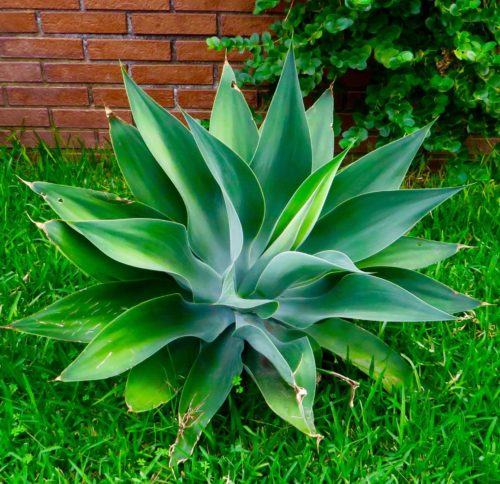
Agave – fabulously vibrant and prickly
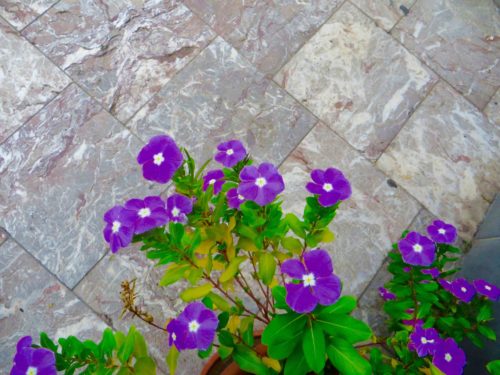
Complementary colours
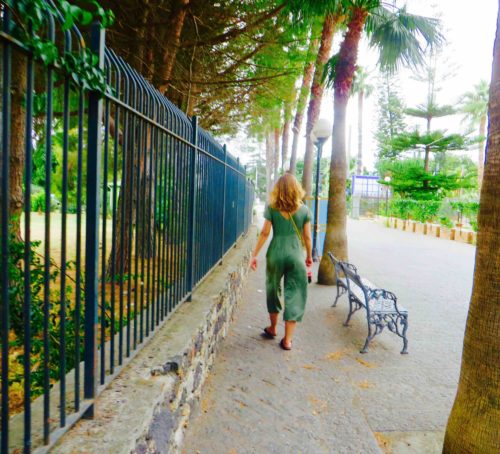
Green vistas …
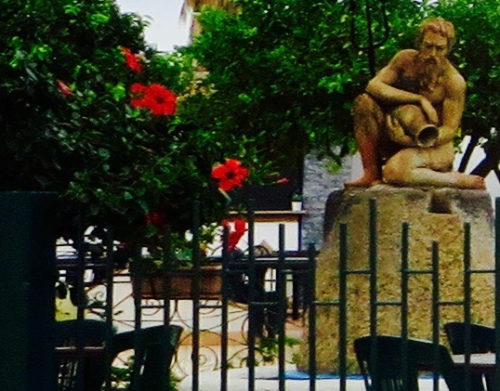
Hibiscus and water carrier
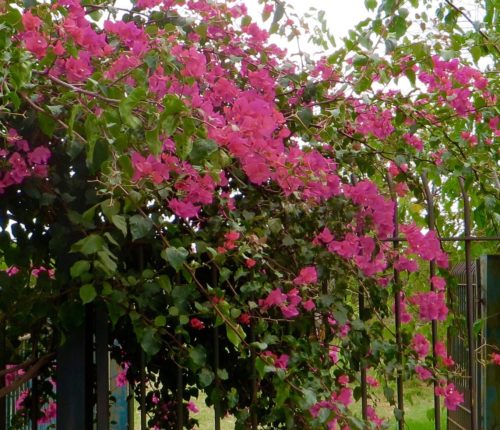
Bougainvillea – queen of southern climes

Giardini-Naxos – Blue Queen

Old lava flow from Etna in the sea being re-colonised …
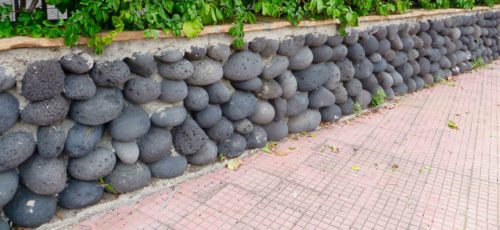
An impressive wall …
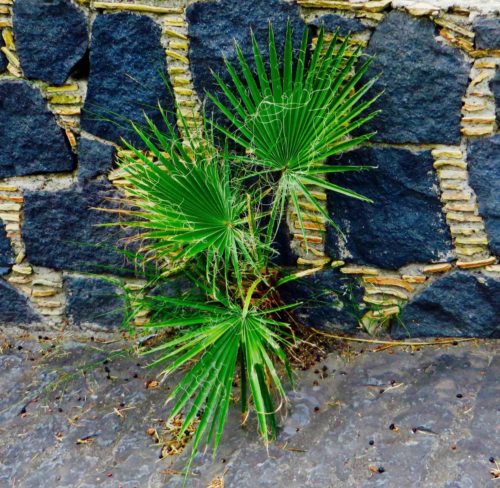
Another impressive way of designing a stylish wall …
We came upon the Archaeological museum by chance. Being the end of the season, we had it to ourselves.
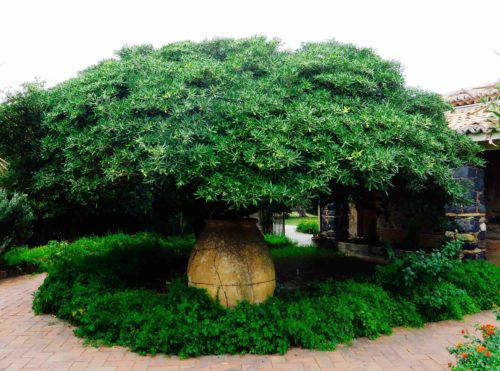
Entrance to the Archaeological Museum, Giardini-Naxos

Welcome to museum …
Here are some of the inhabitants …


lost and found …
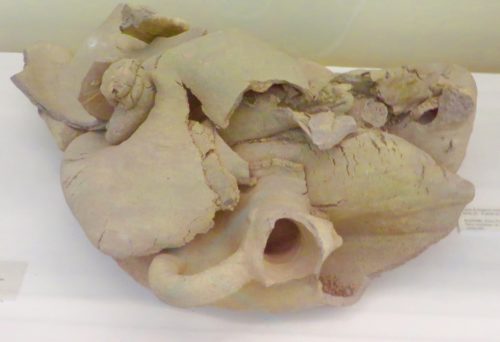
The amphora that never made it …
Just thinking of the hands that squashed it up ! Somehow, it survived when it wasn’t even meant to!
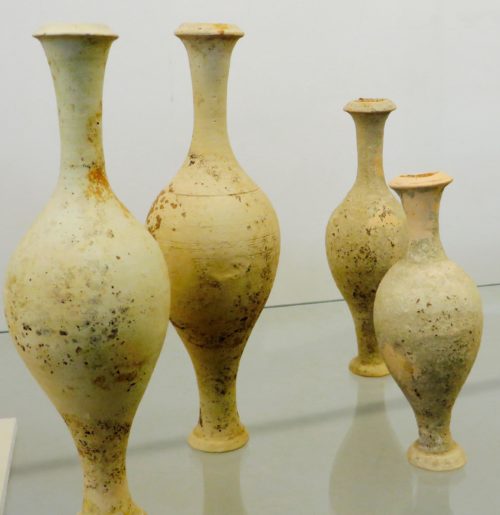
Elegance Incorporated …

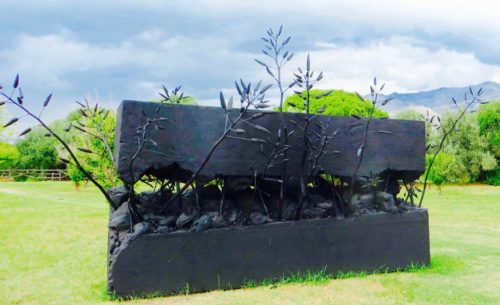
Sculpture in gardens … rebirth in a land of volcanoes and earthquakes …
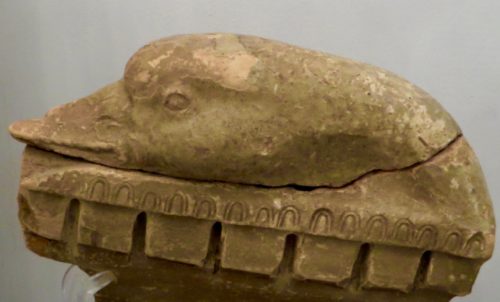
Sleeping goose …
But for us there’s still a long day ahead. We walk back to the hotel along the coast and I manage to do something I’ve failed to achieve during our time here.
I see a movement out of the corner of my eye – I whirl round the camera and press the button without looking. Got it! I think this also would make a great painting – except that I have no talent in that direction!

Lizard!
I was thinking that you could take Sicily as a microcosm of the world. What can be improved e.g. peoples’ living conditions, agriculture into being more organic and self sustaining so we also help to conserve natural habitats for wildlife. What we must get rid of: e.g. plastic waste in the ocean and on land, corruption and greed (difficult) and not least, how we must preserve the history and cultures of the past. And we need the cooperation of people and nations to do this for ourselves and for future generations. There’s a lot of work to be done but small improvements help towards bigger ones.
This has been a tremendous week. I’ve learned a lot about the history of Sicily – so much so, that I know I’ve got a lot more to learn! We’ll be back.
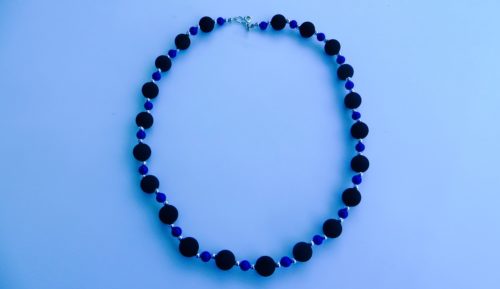
A necklace made of lava from Mount Etna …
END
